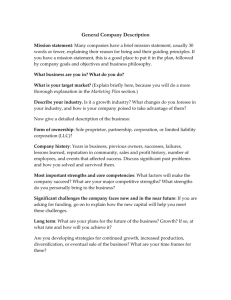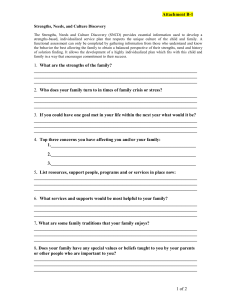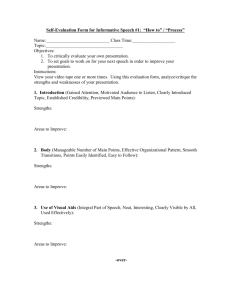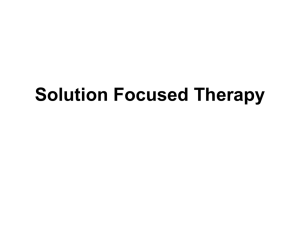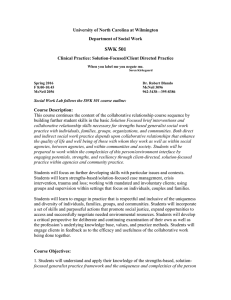Case Presentation
advertisement
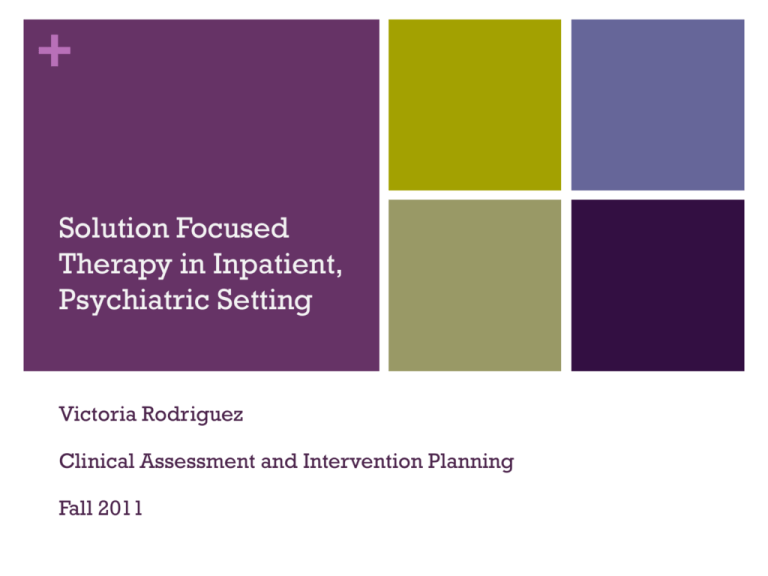
+ Solution Focused Therapy in Inpatient, Psychiatric Setting Victoria Rodriguez Clinical Assessment and Intervention Planning Fall 2011 + Jackson South Community Hospital Short-term “Crisis and Stabilization” Unit, Baker Acts, Medication Management, Self Average length of stay: 3-7 days Doctors, nurses, mental health technicians, activity therapists, and social workers Psychosocial assessment, case management, discharge planning, family sessions + Client Background (“JP”) 31 year old female Unmarried, no children, no pregnancies Living with her mother Unemployed, receiving disability benefits, volunteer work Some college Above average intelligence, cooperative, engaged No reported history or drug or alcohol abuse Caucasian background, does not practice any formal religion Interest in arts, literature, music, and animation + Presenting Problems Hospitalization—Suicidal Letter (“angry letter”) Relationship Conflict with Mother (“Wednesday Adams”) History of BPD, most recent episode Depressed History of noncompliance with medication/treatment Social isolation—could not identify support systems (Aunt) Feelings of helplessness, hopelessness, and guilt, low selfesteem Dysthymic affect, disheveled, slow speech, organized thought processes + Environmental Factors Living with mother Large source of stress Mother also has a history of BPD Dysfunctional care-giving relationship Father “abandoned” family when JP was 8 years old. JP did not have a close relationship to her father prior to this No siblings, only child No other significant social or familial relationships Aunt Solution-Focused Therapy (SFT) •An emphasis on solution talk represents an effective means of helping clients focus on solutions to problems and to act or think differently than they normally do. •Just as the causes of problems do not need to be understood for significant change to occur, a client’s decision to act differently in the future may emerge independently of any problem talk. •Strengths + and resources would be highlighted •Medical •Goals Model of intervention are for clients to focus on solutions to their problems or challenges, discover exceptions to their problems, become more aware of their strengths and resources, and to learn to act and think differently. Why SFT? •Preferred future •Discharge, more contact with the community, more autonomy •Realistic, concrete, observable •“Achievement •Problem-free stages is recognized as a beginning rather than an ending.” talk •Some patients can find their personal identity substantially defined by their problem. •Patient-staff interactions •Exceptions •Helps patients notice triggers and talk about safe, effective behavior management •Resources •Skills + and abilities the patient already has and use them as a foundation •Generalize these to other areas of behavior •Flexibility •Can be delivered in short time frames •Effectiveness with internalizing behavior problems, depression, anxiety, selfconcept, and self-esteem. Effectiveness of SFT was also identified in family group sessions in the areas of expressiveness, active-recreation orientation, moralreligious emphasis, and family congruence. + Assessment and Intervention Approach (Session 1) No large distinction between Assessment and Intervention phases What does the client perceive is the problem? Guilt Family/Gender Expectations Anger What are the client’s beliefs about the sources of the problem? Family Relationships How does the problem affect the client? Self-blame Family Relationships become strained What has helped the client cope in the past? Removing self from situational triggers + Assessment and Intervention Approach (Session 1 continued) The Miracle Question: “Imagine you went to sleep and your problems disappeared, only you didn’t know it. What would you be doing when you woke up?” Book Tour (Confidence!) Positive relationship with mother (Less guilt!) More oriented and comfortable Larger focus on goals What might people notice about you when you were focusing on your goals? “I would seem more ‘with it.’” Happiness Introduction: “Between now and the next time we talk, notice the things in your life that you would like to see continue.” + Goals and Objectives Goal #1: Articulation of 3 strengths as relating to goal maintenance Objective #1: JP will be able to identify and list personal strengths Objective #2: JP will be able to identify when these 3 personal strengths were visible + Goals and Objectives Goal #2: Identify 2 exceptions to problems of guilt and family role conflict Objective #1: JP will describe 2 instances when problem did not exist Objective #2: JP will articulate what was different about these experiences + Goals and Objectives Goal #3: Identification of 2 positive coping skills Objective #1:JP will identify/list triggers to changes in mood and dysthymic feelings Objective #2: JP will recognize 2 skills that have helped her be more positive, less confrontational + Assessment and Intervention Approach (Session 2) What has helped you cope in the past? Removing self from situation Involvement and production of art Self-assertion What are your strengths? Intelligence Personal ethics Generosity Goal-setting (“… notice the things in your life that you would like to see continue.) Enrolling in college classes (by the beginning of the next semester) Exercise, martial arts (1x/wk, within 2 weeks of d/c) Writing, reading, animating (1 hour/per day) Goal maintenance: What needs to happen for these changes to occur? Financial Security Collaboration Self-Confidence + Assessment and Intervention Approach (Session 2 continued) Exceptions to the Problem: “Tell me about a time when the problem didn’t exist.” Intellectual Conversations with Mother Equality Introduction: Surprise Task, “Between now and the next time we meet, do something that will pleasantly surprise your mother.” + JP’s surprise task is that she asked her mother to come visit her. What do you think the possible obstacles might be and how will you address them? Ending and Evaluation (Session 3) Avoiding conflict with mother Reflection on admission How will you remind yourself about the things that you know help? Idle time Social network community building Scaling JP had become aggressive with another patient and had been medicated. Outcome and Progress •JP was discharged the day following the 3rd session. Worker will be unable to follow up with JP unless she is readmitted to the unit. •As part of discharge plan, JP was referred to a psychiatrist as well as a therapist for individual and family counseling. + Outcomes and Progress (Continued) •Progress on Goals of the SFT Intervention •Goal #1: Articulation of 3 strengths as relating to goal maintenance •JP was able to identify 3 personal strengths •Intelligence, Ethics, Generosity •JP was able to identify concrete instances where she utilized her strengths •Mensa, group work, confronting family issues •Goal #2: Identify 2 exceptions to problems of guilt and family role conflict •JP was able to identify 1 situation that was an exception to the problem •Intellectual •JP + conversations with mother about literature was able to identify what was different about this 1 situation •Equality, lack •Goal of a power differential #3: Identification of 2 positive coping skills •JP was able to identify 2 triggers •Mother, family •JP expectations was able to identify 2 coping skill •Diffusion by walking away, emotionless expression Limitations •Evaluation •Agency (Scaling) Focus •Medical model focused on pathology •No opportunity to follow up with client after discharge •Medication •Unclear ending •Time + •Limited interaction with client •Countertransference •Gender •Guilt role conflict with family + References Crownshurst, N. & Bowers, L. (2002) Philosophy, care, and treatment on the psychiatric intensive care unit: themes, trends and future practice. Journal of Psychiatric and Mental Health Nursing. Vol. 9. Issue 6. Pp.689-695 Gingerich, W.J. (2000) Solution-focused brief therapy: A review of the outcome research. Family Process. Vol. 39. Pp. 477-498. Gralton, E., Udu, V., & Ranasinghe, S. (2006). A solution-focused model and inpatient secure settings. The British Journal of Forensic Practice. Vol. 8. Issue 1. Pp. 24-30 Halpern, J. (2003) Empathy and the Practice of Medicine: Beyond Pills and the Scalpel. New Haven: Yale University Press. Iveson, C. (2002) Solution-focused brief therapy. Advances in Psychiatric Treatment. Vol. 8 Pp. 149-157. Kim, J. (2008). Examining the Effectiveness of Solution-Focused Brief Therapy: A MetaAnalysis. Research on Social Work Practice. Vol. 18. Issue 107. Pp. 107-116 Smith, S., Adam, D. & Kirkpatrick, P. (2011). Using solution-focused communication to support patients. Nursing Standard. Vol. 25. Issue 52. P. 42-47. Van Den Bergh, N. Solution Focused Therapy. Class Lecture. 25 Oct 2011. Walsh (2006). Theories for Direct Social Work Practice. (1st Edition) Belmont: Thomson Higher Education.


